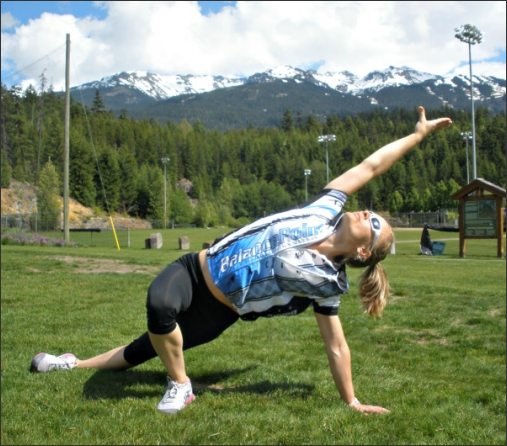Performance Enhancement Warm Up for cyclists and triathletes

Many are still unaware that static or passive stretching prior to a sport performance has more disadvantages than advantages, especially for sports that performance depends on strength, power, speed, and endurance. Studies in the exercise science field show more and more that static stretching is likely an inappropriate warm up for many sports. In his report “Les limites du stretching pour la performance sportive. 1ère partie: Intérêts des Étirements avant et après la performance”, Gilles Cometti of the Université de Bourgogne, France, compiled results from 21 studies on the matter conducted between 1984 and 2002. Here are some highlights:
- Static stretching increases intra-muscular tension, constricting blood vessels, therefore reducing blood flow, muscle oxygenation, and not favouring an increase of body temperature; all together compromising performance, especially in endurance sports such as running, swimming and cycling.
- Static stretching slows down speed in activities requiring successive muscular contractions like sprinting.
- Static stretching decreases the capacity of muscular contraction for up to one hour.
- Static stretching decreases endurance strength required in sports like canoeing and kayaking.
- Static stretching decreases explosive strength important in sports that involve jumping.
- Static stretching decreases the tendons’ capacity of storing energy, therefore compromising sports requiring speed and explosive strength.
More frequently than before, researchers are studying stretching and warm up protocols to see their benefits on performance. In a research article: “An investigation into possible physiological mechanisms associated with changes in performance related to acute response to different preactivity stretch modalities”, by Iain M. Fletcher and Mathew M. Monte-Colombo of the University of Bedfordshire and University of Hertfordshire, United Kingdom, in 2010, concluded that a dynamic stretching warm up improves sport performance the most over a straight jogging warm up. On its side the static stretching warm up demonstrated some drops in performance. Below are some of the author’s conclusions:
- Dynamic stretching increases heart rate, blood flow and body temperature favouring increase in metabolic activities at a cellular level.
- Dynamic stretching decreases resistance in the muscles and joints, therefore giving more freedom of movement.
- Dynamic stretching increases nerve receptors sensitivity (muscle’s ability to respond to stimuli) and nerve conduction velocity (communication speed between brain and muscles), encouraging stronger and quicker muscle contractions.
- Dynamic stretching increases muscle peak torque, playing an important role in speed sports requiring rapid forceful movements.
Please enjoy incorporating this new dynamic warm up routine by Kinesio Majo, specifically set up for enhancing long distance sport performance. (See video at the bottom of this page).
Article written by: Majorie Lauzon
Copyright 2013
References:
- Gilles Cometti, Les limites du stretching pour la performance sportive. 1ère partie: Intérêts des Étirements avant et après la performance, Faculté des Sciences du Sport – UFR STAPS Dijon, BP 27877,21078, Dijon Cedex, France
- Iain M. Fletcher and Mathew M. Monte-Columbo, An investigation into possible physiological mechanisms associated with changes in performance related to acute response to different preactivity stretch modalities, Applied Physiology, Nutrition And Metabolism, Vol. 35, p. 27-24, 2010
Posted: June 07, 2013 In: Cycling, Flexibility Training, Injury Prevention, Strength Training

